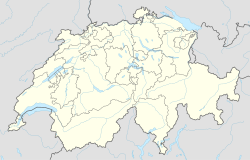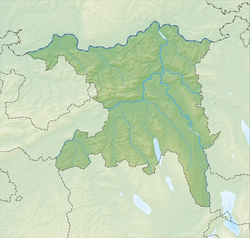Zeihen
| Zeihen | ||
|---|---|---|
 |
||
|
||
| Coordinates: 47°29′N 8°5′E / 47.483°N 8.083°ECoordinates: 47°29′N 8°5′E / 47.483°N 8.083°E | ||
| Country | Switzerland | |
| Canton | Aargau | |
| District | Laufenburg | |
| Area | ||
| • Total | 6.88 km2 (2.66 sq mi) | |
| Elevation | 445 m (1,460 ft) | |
| Population (Dec 2015) | ||
| • Total | 1,102 | |
| • Density | 160/km2 (410/sq mi) | |
| Postal code | 5079 | |
| SFOS number | 4183 | |
| Surrounded by | Bözen, Densbüren, Effingen, Herznach, Hornussen, Linn, Schinznach-Dorf, Thalheim, Ueken | |
| Website |
www SFSO statistics |
|
Zeihen is a municipality in the district of Laufenburg in the canton of Aargau in Switzerland.
Zeihen has an area, as of 2009[update], of 6.88 square kilometers (2.66 sq mi). Of this area, 3.5 km2 (1.4 sq mi) or 50.9% is used for agricultural purposes, while 2.8 km2 (1.1 sq mi) or 40.7% is forested. Of the rest of the land, 0.59 km2 (0.23 sq mi) or 8.6% is settled (buildings or roads), 0.01 km2 (2.5 acres) or 0.1% is either rivers or lakes and 0.01 km2 (2.5 acres) or 0.1% is unproductive land.
Of the built up area, housing and buildings made up 4.7% and transportation infrastructure made up 3.5%. Out of the forested land, 37.5% of the total land area is heavily forested and 3.2% is covered with orchards or small clusters of trees. Of the agricultural land, 23.5% is used for growing crops and 24.4% is pastures, while 2.9% is used for orchards or vine crops. All the water in the municipality is in rivers and streams.
The municipalities of Bözen, Effingen, Elfingen, Hornussen and Zeihen are considering a merger some time in the future into a new municipality with an as yet (as of 2010[update]) undetermined name.
The blazon of the municipal coat of arms is Vert a Pale counter-compony Sable and Or between two Ears of Wheat of the last.
Zeihen has a population (as of December 2015[update]) of 1,102 As of June 2009[update], 8.5% of the population are foreign nationals. Over the last 10 years (1997–2007) the population has changed at a rate of 12.8%. Most of the population (as of 2000[update]) speaks German (92.6%), with Albanian being second most common ( 4.6%) and Serbo-Croatian being third ( 0.8%).
...
Wikipedia




